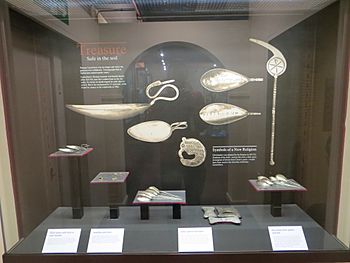Canterbury Treasure facts for kids
Quick facts for kids Canterbury Treasure |
|
|---|---|

The Canterbury Treasure, as displayed in the Canterbury Roman Museum
|
|
| Material | Silver |
| Writing | Latin |
| Created | Late 4th or early 5th Century AD |
| Discovered | 1962 |
| Present location | Roman Museum, Canterbury |
The Canterbury Treasure is a really cool collection of silver items and jewelry from ancient Roman times. It was found in 1962 in the city of Canterbury, Kent, in England. Today, you can see it at the Roman Museum in Canterbury. Some copies of the main pieces are also kept at the British Museum.
Contents
How Was the Treasure Found?
An Accidental Discovery
This amazing treasure was found by accident in 1962. Workers were doing road construction in an area of Canterbury called Longmarket. As they dug, they uncovered these ancient Roman objects!
Declared a "Treasure Trove"
When old valuables like this are found, they are sometimes called "treasure trove." This means they were likely hidden long ago and the owner never came back for them. The city council bought the treasure to display it at the Roman Museum. This museum had just opened the year before.
More Pieces Emerge
Years later, in 1982, five more pieces of the treasure appeared on the market in London. These items had not been reported when the main treasure was first found. They were also declared "treasure trove" and bought by the museum a year later.
Why Was It Buried?
The Canterbury Treasure was probably buried around the early 5th century AD. This was a time when the Romans were leaving Britain. The person who owned the treasure might have been a silversmith, someone who worked with silver. They likely buried their valuable items for safe-keeping, hoping to come back for them later. But, for some reason, they never did.
What's Inside the Treasure?
Silver Objects and Jewelry
The treasure is mostly made up of small silver objects and beautiful jewelry. Many of these items have Christian iconography on them. This means they have symbols or pictures related to Christianity.
Special Spoons and Ingots
Among the silver objects are two spoons with cool swan-shaped handles. There are also ten other spoons. One of these spoons has a sea stag engraved on it. Another spoon has the words 'viribonum' written in Latin, which means 'I belong to a good man.' The treasure also includes a toothpick, a rough silver bar, and three silver ingots. An ingot is a block of metal. Each of these ingots weighs about one Roman pound.
Gold and Silver Jewelry
The jewelry in the treasure is also very interesting. There's a gold finger ring with a green glass stone set into it. There's also a gold necklace clasp and a silver pin.
Dating the Treasure
One of the coins found with the treasure helps us figure out when it was buried. This coin was made in Milan during the time of Emperor Honorius. This tells us that the treasure must have been hidden sometime after the year 402 AD.
Gallery







